|
If you're an outdoorsy type of person and live in Florida or Georgia, there's a good chance you've heard of Cumberland Island National Seashore. One of the largest undeveloped barrier islands on the Atlantic Coast, Cumberland Island is an oak covered paradise only 45 minutes off the coast of Georgia via ferry. We've been trying to get to Cumberland Island for probably ten years now? I'm not sure. I had been dreaming of visiting ever since our high school biology teacher assigned a project on coastal ecosystems. I finally got around to editing the photos I took during our trip (in November, yikes!) and let me assure you, it lives up to all of the daydreaming. 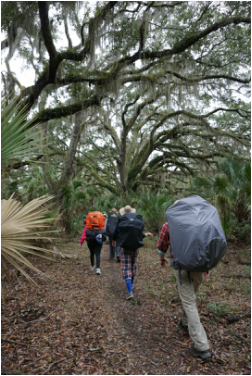 The island is covered in wind-worn oaks, spacious pine stands, salt marshes, and coastal scrub ecosystems. The island's 50-miles of trails are well maintained and campsites are intimate with vegetation cover and primitive benches. You aren't allowed to have campfires in the wilderness camp sites so if your camping experience requires s'mores, stay at the Sea Camp or Stafford Beach campgrounds. You can learn more about the camping arrangements at this website. NOTE: All camping requires a permit and some campsites are first-come first serve. There is non-potable water available in the wilderness area from a sulfur well; so, make sure you bring some Gatorade if you are sensitive to the flavor. We stayed at the Hickory Hill wilderness campsite and had plenty of room for three large tents (4 person) and three small tents (2 person). Hickory Hill is a nice and easy 5.5 mile hike from the ferry drop off so you'll have time to explore once arriving at camp. It rained for most of our trip, but like all Florida hikers we relished in the cooler temperatures and misty ambiance. I'll take drizzly and cool over hot and muggy ANY DAY. The cold weather inspired one of the best backpacking meals of my life thus far ... fresh from scratch Fettuccine Carbonara with peas and bacon. To die for. Recipe post coming soon! If you get the chance, I highly recommend a weekend at Cumberland Island National Seashore. As the second National Park System trip I've done where you must take a ferry, I can personally recommend this style of camping for a relaxing and more secluded wilderness experience close to civilization. Have fun and get outdoors!
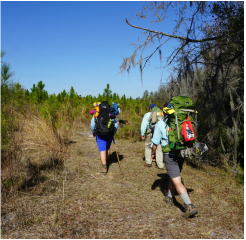 Backpacking along the Suwanee River, 2015 Backpacking along the Suwanee River, 2015
Close your eyes. Imagine your stereotypical backpacking trip. You've hiked all day. If you're in Florida during the summer, you're bug bitten and hot in the face. You're probably near water and you're probably tired. Meal time. What's for dinner?
If a dehydrated, one-pot meal came to mind, you've probably done this before. Now, what if I told you that we can change that? Imagine instead, same scenario, you come into camp eagerly anticipating from-scratch linguine alfredo carbonara and cocktail hour with sliced salami and location-themed cocktails. All of a sudden, eating dinner goes from a chore to an activity among friends. 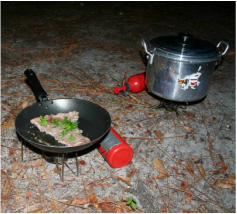 Cooking one of our first Bistec de Palomilla steaks in 2005 Cooking one of our first Bistec de Palomilla steaks in 2005
We gave up the dehydrated style of backpacking in 2005. I took a backpacking class during my time at UF mostly for kicks but also because I needed a one-credit class to round out my semester enrollment. Every student had to plan a two-night backpacking trek for at least three friends. Additionally, there were three percentage points of extra-credit on the table for the backpacking trip which planned and executed the best menu. Challenge accepted!
By this time, I had been on more backpacking trips than I could count and hiked Philmont Scout Ranch twice (100+ mile treks). Feeling that we should take things up a notch to keep it interesting, we decided to remake one of our favorite meals - Bistec de Palomilla with yellow rice. The recipe, a great first foray into fresh food while backpacking, is at the end of this article.
To make real food while camping, there are a few things you need to do and know.
Carnevale's Backcountry Bistec de Palomilla
Ingredients: (serves four)
Recipe:
When you get to camp, fire up your camp stove or a campfire to cook your rice and then, 'cook' the steaks. Remember, the meat is cooked already, all you have to do is heat it up! You'll want to cook each steak for a few minutes over high heat; until it is texturally like a steak cooked to medium. Try not to overcook it, err on the side of medium-rare as opposed to medium-well; these acid-soaked thin sirloins will turn to shoe leather if over-done! When the steaks are done, remove them and throw your probably thawed yellow rice in the pan with the steak juices. Heat until warm throughout and dish out to your hungry campers!
Keeping the meat safe, while un-refrigerated, is a top priority but always a gamble. This recipe keeps the meat as cold as possible for as long as possible and as a contingency plan, soaks the meat in a high-acid environment. This high-acid environment essentially "cooks" the meat while providing inhospitable conditions for food-borne pathogens; the same process which is at work in any ceviche dish.
Please note: We are not trained chefs or medical professionals. We are not responsible for any illness or other unfortunate event that may occur if you choose to make this meal on a backpacking, or other camping, trip. We have made this meal several times with no ill effect and are sharing our recipe to enrich others' experiences. If you have any questions or comments, please leave them below. My blog post, comments, and responses are never intended as medical advice.
Our MSR Dragonfly stove was purchased over ten years ago with no compensation for my opinion. However, in the interest of full disclosure, I may earn a small commission if you purchase items through the link provided here. There is no increase in cost, to you or anyone else, associated with these links. |
The
|
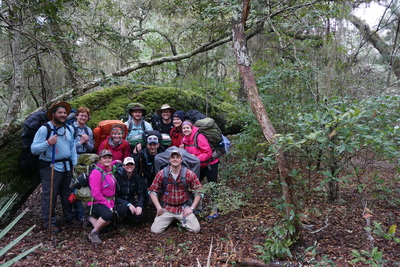
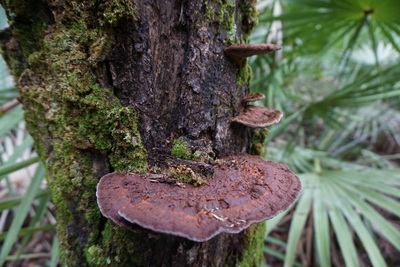
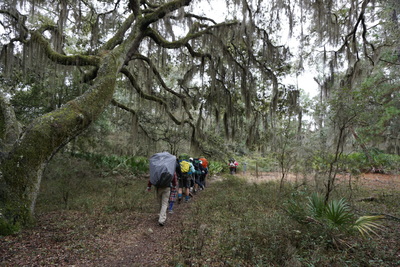
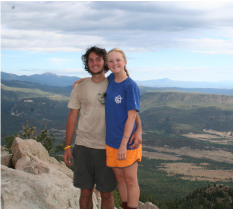

 RSS Feed
RSS Feed
